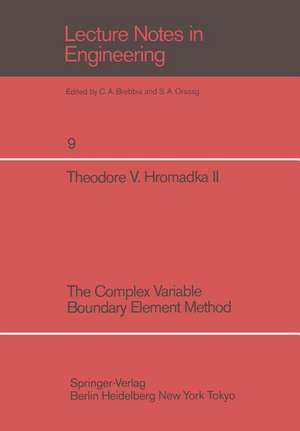The Complex Variable Boundary Element Method: Lecture Notes in Engineering, cartea 9
Autor T. V. Hromadkaen Limba Engleză Paperback – noi 1984
Din seria Lecture Notes in Engineering
- 15%
 Preț: 640.37 lei
Preț: 640.37 lei - 15%
 Preț: 643.34 lei
Preț: 643.34 lei - 15%
 Preț: 632.70 lei
Preț: 632.70 lei - 18%
 Preț: 1049.30 lei
Preț: 1049.30 lei - 15%
 Preț: 637.59 lei
Preț: 637.59 lei - 15%
 Preț: 638.89 lei
Preț: 638.89 lei - 15%
 Preț: 637.93 lei
Preț: 637.93 lei - 15%
 Preț: 635.96 lei
Preț: 635.96 lei - 15%
 Preț: 637.78 lei
Preț: 637.78 lei - 18%
 Preț: 957.13 lei
Preț: 957.13 lei -
 Preț: 397.01 lei
Preț: 397.01 lei - 15%
 Preț: 653.79 lei
Preț: 653.79 lei - 15%
 Preț: 638.57 lei
Preț: 638.57 lei - 15%
 Preț: 634.82 lei
Preț: 634.82 lei - 15%
 Preț: 644.18 lei
Preț: 644.18 lei - 15%
 Preț: 635.15 lei
Preț: 635.15 lei - 15%
 Preț: 637.93 lei
Preț: 637.93 lei - 15%
 Preț: 633.19 lei
Preț: 633.19 lei - 15%
 Preț: 653.79 lei
Preț: 653.79 lei - 15%
 Preț: 636.45 lei
Preț: 636.45 lei - 15%
 Preț: 651.02 lei
Preț: 651.02 lei - 20%
 Preț: 645.31 lei
Preț: 645.31 lei - 15%
 Preț: 639.08 lei
Preț: 639.08 lei - 15%
 Preț: 633.19 lei
Preț: 633.19 lei - 15%
 Preț: 655.13 lei
Preț: 655.13 lei - 15%
 Preț: 652.49 lei
Preț: 652.49 lei - 15%
 Preț: 652.81 lei
Preț: 652.81 lei - 15%
 Preț: 643.48 lei
Preț: 643.48 lei - 15%
 Preț: 638.24 lei
Preț: 638.24 lei - 20%
 Preț: 640.51 lei
Preț: 640.51 lei - 15%
 Preț: 675.58 lei
Preț: 675.58 lei - 15%
 Preț: 639.59 lei
Preț: 639.59 lei - 15%
 Preț: 642.18 lei
Preț: 642.18 lei - 15%
 Preț: 638.43 lei
Preț: 638.43 lei -
 Preț: 434.12 lei
Preț: 434.12 lei - 15%
 Preț: 642.68 lei
Preț: 642.68 lei - 15%
 Preț: 647.27 lei
Preț: 647.27 lei - 15%
 Preț: 655.92 lei
Preț: 655.92 lei - 15%
 Preț: 665.73 lei
Preț: 665.73 lei -
 Preț: 411.64 lei
Preț: 411.64 lei -
 Preț: 406.80 lei
Preț: 406.80 lei - 15%
 Preț: 634.68 lei
Preț: 634.68 lei - 15%
 Preț: 650.86 lei
Preț: 650.86 lei - 18%
 Preț: 974.49 lei
Preț: 974.49 lei - 15%
 Preț: 642.68 lei
Preț: 642.68 lei - 15%
 Preț: 635.31 lei
Preț: 635.31 lei - 15%
 Preț: 640.37 lei
Preț: 640.37 lei - 15%
 Preț: 636.45 lei
Preț: 636.45 lei - 20%
 Preț: 659.63 lei
Preț: 659.63 lei - 15%
 Preț: 651.51 lei
Preț: 651.51 lei
Preț: 640.37 lei
Preț vechi: 753.39 lei
-15% Nou
Puncte Express: 961
Preț estimativ în valută:
122.53€ • 128.39$ • 101.30£
122.53€ • 128.39$ • 101.30£
Carte tipărită la comandă
Livrare economică 11-25 aprilie
Preluare comenzi: 021 569.72.76
Specificații
ISBN-13: 9783540137436
ISBN-10: 3540137432
Pagini: 260
Ilustrații: XII, 246 p.
Dimensiuni: 170 x 244 x 14 mm
Greutate: 0.42 kg
Ediția:Softcover reprint of the original 1st ed. 1984
Editura: Springer Berlin, Heidelberg
Colecția Springer
Seria Lecture Notes in Engineering
Locul publicării:Berlin, Heidelberg, Germany
ISBN-10: 3540137432
Pagini: 260
Ilustrații: XII, 246 p.
Dimensiuni: 170 x 244 x 14 mm
Greutate: 0.42 kg
Ediția:Softcover reprint of the original 1st ed. 1984
Editura: Springer Berlin, Heidelberg
Colecția Springer
Seria Lecture Notes in Engineering
Locul publicării:Berlin, Heidelberg, Germany
Public țintă
ResearchCuprins
1: Flow Processes and Mathematical Models.- 1.0 Introduction.- 1.1 Ideal Fluid Flow.- 1.2 Steady State Heat Flow.- 1.3 Saturated Groundwater Flow.- 1.4 Steady State Fickian Diffusion.- 1.5 Use of the Laplace Equation.- 2: A Review of Complex Variable Theory.- 2.0 Introduction.- 2.1 Preliminary Definitions.- 2.2 Polar Forms of Complex Numbers.- 2.3 Limits and Continuity.- 2.4 Derivatives.- 2.5 The Cauchy-Riemann Equations and Harmonic Functions.- 2.6 Complex Line Integration.- 2.7 Cauchy’s Integral Theorem.- 2.8 The Cauchy Integral Formula.- 2.9 Taylor Series.- 2.10 Program 1: A Complex Polynomial Approximation Method.- 2.11 Potential Theory and Analytic Functions.- 3: Mathematical Development of the Complex Variable Boundary Element Method.- 3.0 Introduction.- 3.1 Basic Definitions.- 3.2 Linear Global Trial Function Characteristics.- 3.3 The H1 Approximation Function.- 3.4 Higher Order Hk Approximation Functions.- 3.5 Engineering Applications.- 4: The Complex Variable Boundary Element Method.- 4.0 Introduction.- 4.1 A Complex Variable Boundary Element Approximation Model.- 4.2 The Analytic Function Defined by the Approximator $$\rm \hat{\omega }$$(z).- 4.3 Program 2: A Linear Basis Function Approximator $$\rm \hat{\omega }$$(z).- 4.4 A Constant Boundary Element Method.- 4.5 The Complex Variable Boundary Element Method (CVBEM).- 5: Reducing CVBEM Approximation Relative Error.- 5.0 Introduction.- 5.1 Application of the CVBEM to the Unit Circle.- 5.2 Approximation Error from the CVBEM.- 5.3 A CVBEM Modeling Strategy to Reduce Approximation Error.- 5.4 A Modified CVBEM Numerical Model.- 5.5 Program 3: A Modified CVBEM Numerical Model.- 5.6 Determining some Useful Relative Error Bounds for the CVBEM.- 6: Advanced Topics.- 6.0 Introduction.- 6.1 Expansion of the HkApproximation Function.- 6.2 Upper Half Plane Boundary Value Problems.- 6.3 Sources and Sinks.- 6.4 The Approximative Boundary for Error Analysis.- 6.5 Estimating Boundary Spatial Coordinates.















